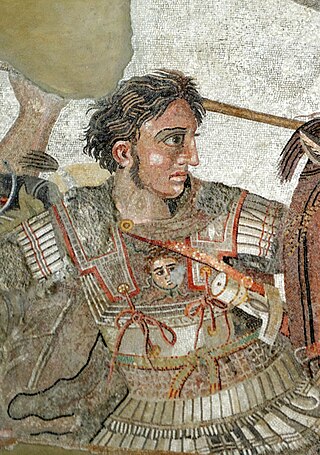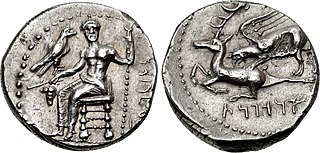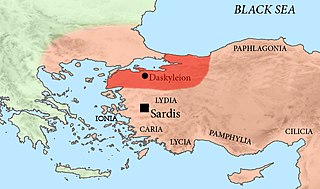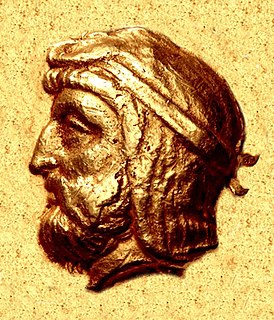
Hyrcania is a historical region composed of the land south-east of the Caspian Sea in modern-day Iran, bound in the south by the Alborz mountain range and the Kopet Dag in the east.

The wars of Alexander the Great were fought by King Alexander III of Macedon, first against the Achaemenid Persian Empire under Darius III, and then against local chieftains and warlords as far east as Punjab, India. Due to the sheer scale of these wars, and the fact that Alexander was generally undefeated in battle, he has been regarded as one of the most successful military commanders of all time. By the time of his death, he had conquered most of the world known to the ancient Greeks. Although being successful as a military commander, he failed to provide any stable alternative to the Achaemenid Empire—his untimely death threw the vast territories he conquered into civil war.

Ariarathes I was the last Persian Achaemenid governor (satrap) of the province (satrapy) of Northern Cappadocia, serving from the 340s BC to 331 BC. He led defensive efforts against the Macedonian invasion, commanded by Alexander the Great, and later fought at the Battle of Gaugamela under Darius III, the last King of Kings of the Achaemenid Empire. After the fall of the Achaemenid Empire, Ariarathes I continued his resistance against the Macedonians and established the Kingdom of Cappadocia, becoming the first ruler of the Iranian Ariarathid dynasty.
Mithrenes was a Persian commander of the force that garrisoned the citadel of Sardis. According to Cyril Toumanoff, he was also a member of the Orontid dynasty, of Iranian origin. Waldemar Heckel, on the other hand, considers Mithrenes to be a Persian noble of unknown family background. After the battle of the Granicus Mithrenes surrendered voluntarily to Alexander the Great, and was treated by him with great distinction. Mithrenes was present in the Macedonian camp after the Battle of Issus, and Alexander ordered him to visit the captured family of Darius III and assure them that Darius was alive, before changing his mind and assigning the duty to Leonnatus instead. He fought for Alexander at Gaugamela, and ironically he was fighting against an army that included his father Orontes II. Afterwards, Alexander appointed him Satrap of Armenia.

Atropates was a Persian nobleman who served Darius III, then Alexander the Great, and eventually founded an independent kingdom and dynasty that was named after him. Diodorus (18.4) refers to him as 'Atrapes', while Quintus Curtius (8.3.17) erroneously names him 'Arsaces'.

Neoptolemus was a Macedonian officer who served under Alexander the Great.

Media is a region of north-western Iran, best known for having been the political and cultural base of the Medes. During the Achaemenid period, it comprised present-day Azarbaijan, Iranian Kurdistan and western Tabaristan. As a satrapy under Achaemenid rule, it would eventually encompass a wider region, stretching to southern Dagestan in the north. However, after the wars of Alexander the Great, the northern parts were separated due to the Partition of Babylon and became known as Atropatene, while the remaining region became known as Lesser Media.

Megabazus, son of Megabates, was a highly regarded Persian general under Darius, of whom he was a first-degree cousin. Most information about him comes from The Histories by Herodotus.

Mazaeus, Mazday or Mazaios (Greek:Μαζαῖος) was a Persian noble and satrap of Cilicia and later satrap of Babylon for the Achaemenid Empire, a satrapy which he retained under Alexander the Great.

Abulites was the Achaemenid satrap (governor) of Susiana during the reign of Darius III, and retained the satrapy as a Hellenistic satrap under Alexander the Great until circa 324 BC, when he was executed for sedition.

Aryandes was the first Achaemenid satrap of ancient Egypt between the 6th and 5th centuries BCE, during the early 27th Dynasty of Egypt.

The Achaemenid conquest of the Indus Valley refers to the Achaemenid military conquest and occupation of the territories of the North-western regions of the Indian subcontinent, from the 6th to 4th centuries BC. The conquest of the areas as far as the Indus river is often dated to the time of Cyrus the Great, in the period between 550-539 BCE. The first secure epigraphic evidence, given by the Behistun Inscription inscription, gives a date before or about 518 BCE. Achaemenid penetration into the area of the Indian subcontinent occurred in stages, starting from northern parts of the River Indus and moving southward. These areas of the Indus valley became formal Achaemenid satrapies as mentioned in several Achaemenid inscriptions. The Achaemenid occupation of the Indus Valley ended with the Indian campaign of Alexander the Great circa 323 BCE. The Achaemenid occupation, although less successful than that of the later Greeks, Sakas or Kushans, had the effect of acquainting India to the outer world.

The Thirty-first Dynasty of Egypt, also known as the Second Egyptian Satrapy, was effectively a short-lived province (satrapy) of the Achaemenid Persian Empire between 343 BC to 332 BC. It was founded by Artaxerxes III, the King of Persia, after his reconquest of Egypt and subsequent crowning as Pharaoh of Egypt, and was disestablished upon the conquest of Egypt by Alexander the Great.

Hellespontine Phrygia or Lesser Phrygia was a Persian satrapy (province) in northwestern Anatolia, directly southeast of the Hellespont. Its capital was Dascylium, and for most of its existence it was ruled by the hereditary Persian Pharnacid dynasty. Together with Greater Phrygia, it made up the administrative provinces of the wider Phrygia region.

Frataraka is an ancient Persian title, interpreted variously as “leader, governor, forerunner”. It is an epithet or title of a series of rulers in Persis from 3rd to mid 2nd century BC, or alternatively between 295 and 220 BC, at the time of the Seleucid Empire, prior to the Parthian conquest of West Asia and Iran. Studies of frataraka coins are important to historians of this period.

Mazaces, also Mazakes, was the last Achaemenid satrap of ancient Egypt during the late reign of Darius III of the 31st Dynasty of Egypt.

Sir William Smith was an English lexicographer. He also made advances in the teaching of Greek and Latin in schools.

The Dictionary of Greek and Roman Biography and Mythology is an encyclopedia/biographical dictionary. Edited by William Smith, the dictionary spans three volumes and 3,700 pages. It is a classic work of 19th-century lexicography. The work is a companion to Smith's Dictionary of Greek and Roman Antiquities and Dictionary of Greek and Roman Geography.

Boston is the capital and most populous city of the Commonwealth of Massachusetts in the United States. The city proper covers 48 square miles (124 km2) with an estimated population of 694,583 in 2018, making it also the most populous city in New England. Boston is the seat of Suffolk County as well, although the county government was disbanded on July 1, 1999. The city is the economic and cultural anchor of a substantially larger metropolitan area known as Greater Boston, a metropolitan statistical area (MSA) home to a census-estimated 4.8 million people in 2016 and ranking as the tenth-largest such area in the country. As a combined statistical area (CSA), this wider commuting region is home to some 8.2 million people, making it the sixth most populous in the United States.
























